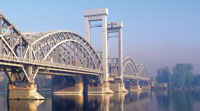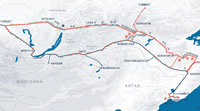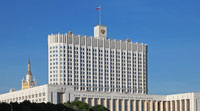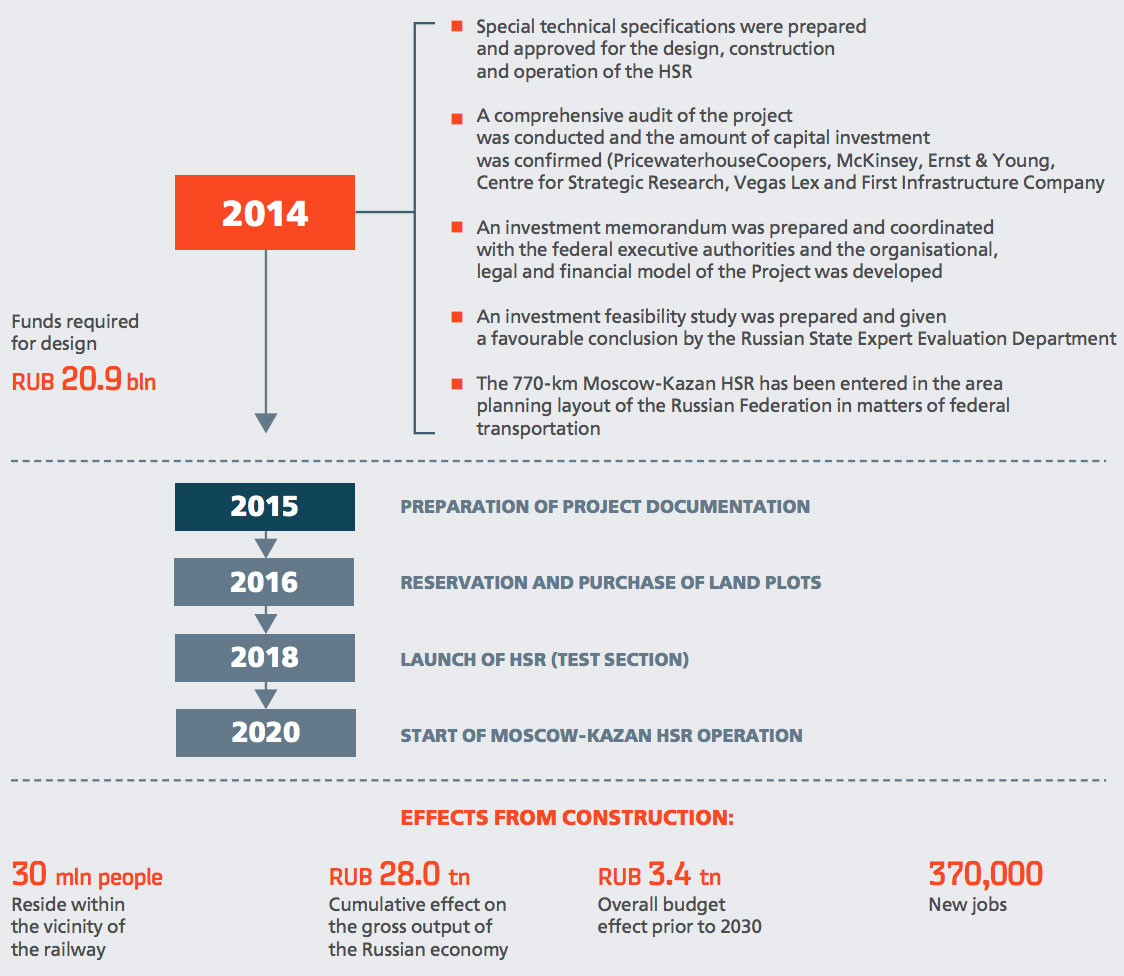High-speed transportation
High-speed transportation is handled by the High-Speed Transportation Directorate — a branch of Russian Railways.
Sapsan and Lastochka trains on long-haul domestic routes in 2014 carried 3.7 mln passengers An increase of 1.8% compared with 2013
Passenger turnover via high-speed trains grew 3.9% to 2.0 bln passenger km in 2014.
- passenger turnover via long-haul high-speed trains on domestic routes totalled 1,936.2 mln passenger km (growth of 2.8%);
- passenger turnover via high-speed trains on international routes totalled 63.3 mln passenger km versus 39.9 mln passenger km in 2013.
The number of passengers transported by high-speed trains increased 2.5% to 3.9 mln in 2014 compared with 2013:
- Sapsan and Lastochka (Desiro RUS) trains carried 3.7 mln passengers on long-haul domestic routes (growth of 1.8%);
- Allegro trains carried 0.213 mln passengers on international routes (a decrease of 12%). Declining passenger traffic along Russian-Finnish routes has been a general trend for all carriers and is primarily related to the lower economic growth rates and the rouble’s exchange rate.
In order to meet growing demand for transportation between Moscow and St Petersburg in 2014, two double-decker Sapsan trains were put into operation in August 2014. Since the launch of the double-decker trains, passenger traffic has increased 25% versus the same period (October) of 2013. The train occupancy rate was 84.6%.
At present, the Sapsan double-decker electric train is the longest high-speed train in the world and is capable of transporting more than a thousand passengers per trip. The train is 500.78 metres long. This is the first such trial operation for such a long high-speed train running on direct current.
Regular Lastochka (Desiro RUS) trains began running along the Moscow-Kursk route in June 2014 and the Moscow-Smolensk route in July to further develop high-speed traffic in the Russian Federation.
| Operating section | Length, km | Operating speed, km/h | Operation start date | Rolling stock | Travel time | Average route speed, km/h | Pairs of trains per day |
|---|---|---|---|---|---|---|---|
| St Petersburg-Helsinki | 442 | 220 | 12/12/2010 | Allegro 7 | 122.8 | 4 | |
| St Petersburg-Moscow | 646 | 250 | 17/12/2009 | Sapsan 10/20 | 3 h 40 m— 4 h 15 m | 161.2–176.5 | 8 |
| Moscow-Nizhny Novgorod | 442 | 160 | 20/07/2010 | Sapsan 10 | 3 h 55 m | 113 | 2 |
| 27/01/2015 | Lastochka 10 | 4 h 00 m | 110.5 | 3 | |||
| Moscow-Kursk | 539 | 140 | 01/07/2014 | Lastochka 5/10 | 5 h 50 m | 92.4 | 2 |
| Moscow-Smolensk | 419 | 140 | 01/07/2014 | Lastochka 5 | 4 h 34 m | 91.8 | 2 |
High-speed transportation by Russian Railways (branch — High-Speed Transportation Directorate) generated a financial result of RUB 2,044.6 mln in 2014.
Key HSR projects
A pilot high-speed railway (HSR) project under way in Russia involves the construction of an HSR from Moscow to Kazan with an extension to Yekaterinburg.
In just the first 12 years of the operation of HSR–2, Russia’s cumulative GDP growth is estimated at RUB 11.7 tn. Projected prices
This project will help to meet the growing demand in Russian cities for passenger transportation, reduce travel time and offer a whole new level of service.
The project aims to offer the highest level of transportation reliability and safety and provide passengers with the proper level of comfort. The most advanced technologies and equipment will be used to meet these objectives.
Moscow-Kazan High-Speed Railway
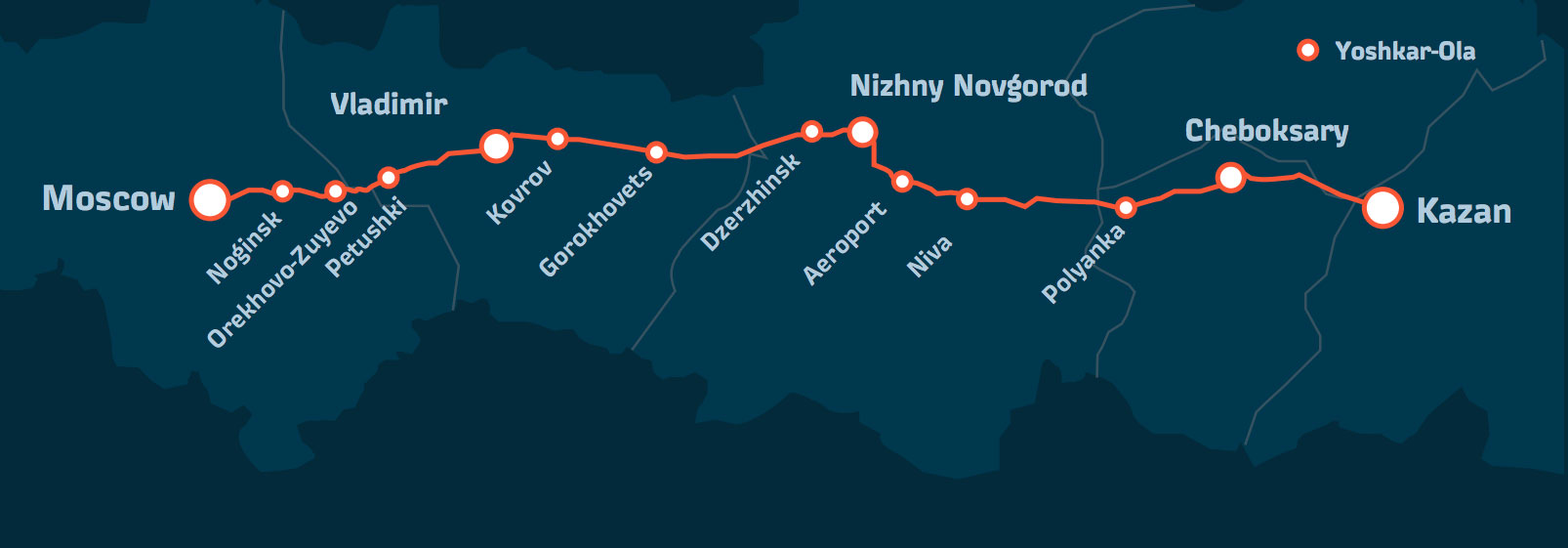
| Railway location | Moscow, Moscow Region, Vladimir Region, Nizhny Novgorod Region, Chuvash Republic, Mari El Republic and Republic of Tatarstan |
| Length | Moscow-Kazan — 770 km, Moscow-Nizhny Novgorod — 423 km, Moscow-Cheboksary — 643 km |
| Operating traffic speed | up to 350 km/h |
| 3 h 30 min | |
| Construction period | 4 years |
A number of measures were implemented in 2014 to prepare for the construction of the Moscow-Kazan High Speed Railway. In particular, an investment feasibility study of the project was prepared and approved by the Russian State Expert Evaluation Department. A technology and price audit of the project was conducted with leading international partners, and special technical specifications were prepared and approved for the design, construction and operation of the high-speed railway.
The Russian Government has decided to start developing design documentation and conducting engineering surveys and has allocated funds of RUB 20.9 bln for these purposes in
In addition, a Russian-Chinese memorandum in high-speed railway transportation was signed in October 2014 as part of the development of partnership relations with the People’s Republic of China.
The memorandum aims to develop the Moscow-Beijing Eurasian High-Speed Transport Corridor, which includes the priority project Moscow-Kazan HSR (the total length of the corridor between the capitals is 7,800 km, including more than 3,000 km of tracks that pass through Chinese territory from Beijing to Urumchi and are in the final stage of construction).

